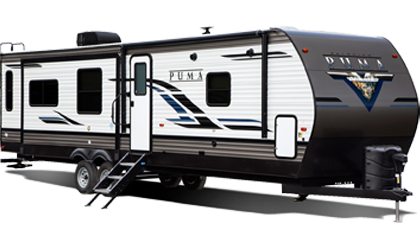RV Wind Driving Tips

Driving an RV is scary for first-timers. It’s a much bigger vehicle than you’re used to driving around. Unless you’re a professional bus driver. Things that you don’t really think much about when you’re driving your car in town can become a big deal when you find yourself behind the wheel of an RV. Check out these tips for driving in windy conditions, and learn how to keep your family and your rig safe if this happens to you.
Blinding you With Science – Just a Little
Why is it so dangerous to drive an RV in the wind? Well, we’re going to have a quick science lesson (don’t worry, no pop quizzes here!). Since your rig is much larger than an average car or truck it’s got more surface area. When there’s more surface area there’s more resistance for the wind to blow around, which is why it’s more difficult to control your RV in these conditions. You see the same issue if you’re driving a big rig on the open road, and this concept of surface area is to blame. (That wasn’t so bad, was it?)
Anyway the Winds Blow – Wait, I Didn’t Mean It!
So the winds are howling. And you’re driving along the road wondering how you’re gonna press on through. These first two tips are kind of no-brainers: slow down so you can safely navigate your way if you absolutely have to be moving. Driving when you’re uncomfortable is dangerous for you and your passengers, but also for the people around you.If you’re uncomfortable driving in the situation or if you can afford to pull over to wait it out, you should stop somewhere safe like a rest stop or parking lot.
If you have to stop somewhere on the shoulder and can find an overpass to park under, it will give you some shelter from the storm to wait it out. If you’re parked in a lot or unprotected area it’s best to point the nose of your RV into the wind to minimize your exposed surface area. RVs are made to be driven (and forward, not in reverse). This being said, the nose and front of your rig are the most aerodynamic places designed to deal with a windy situation.
Another pretty obvious factor here: keep both hands on the wheel and take breaks. You’ll have more control over your steering, just like when you’re driving your car. Also consider taking breaks more frequently. It’s exhausting to have to fight your way down the road and the stress takes a toll on drivers. You’re more likely to be tired and should give your mind time to rest.
Finally, be aware of your surroundings – both vehicles and wind breaks. That surface area (yup, it’s coming up again) also reacts to vehicles passing you. Especially if it’s another RV or big rig, the wind generated from their vehicle is enough to blow you right off course. Wind breaks like overpasses can be a challenge when it’s really windy. Passing under one when you’re compensating on the open road might make you overcorrect in the sheltered space. Making yourself aware of these moments and preparing for them is the best way to handle wind breaks.
There She Blows. Uh. Blew.
And now you’re in a pickle. You thought you could make it through. So you trudged forward and that last big gust tipped over your rig. And your towing vehicle. You’re sitting in a pile of rubble where your beauty once stood. Now what? Unfortunately, there isn’t much you can do in this situation except call for a tow truck and make sure everyone is OK. There are insurance coverage options that also allow for towing and emergency services to help lighten the load of having to pay out-of-pocket for it. If you do a lot of driving it could be well worth the time and effort to invest in this extra coverage.
We talk about the weather a lot. Whether it’s nice outside, cold, raining. But when we’re not driving an RV every day it’s easy to take advantage of or completely ignore simple things like wind. Understanding why it’s more difficult to drive in windy conditions, learning how to cope with the difficulties can help keep you safely on the road, enjoying your Good Life.















